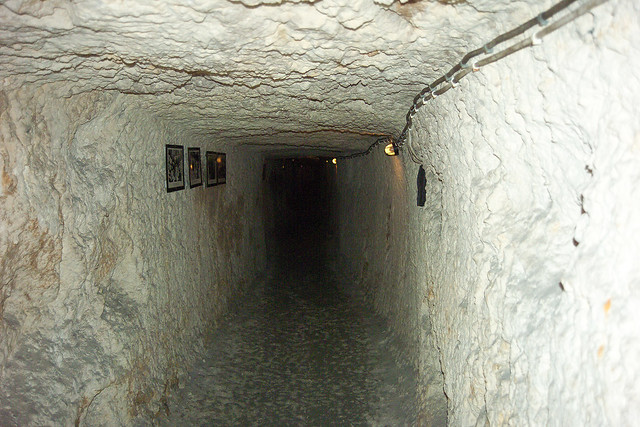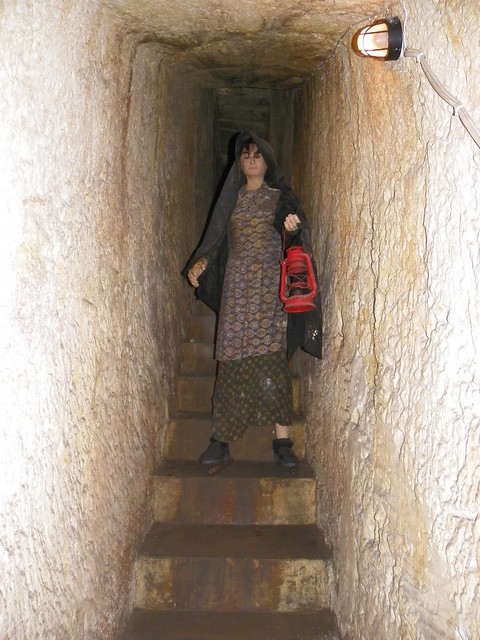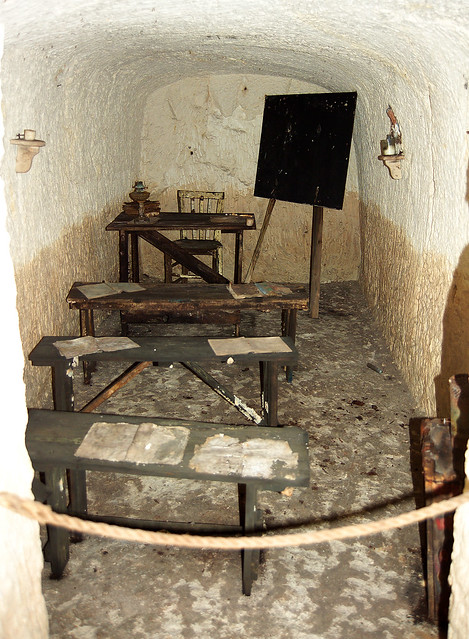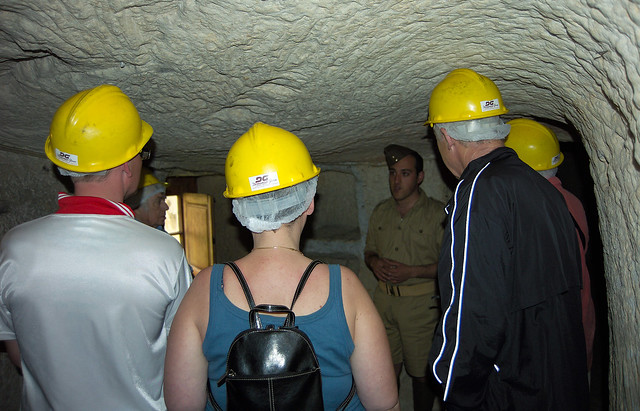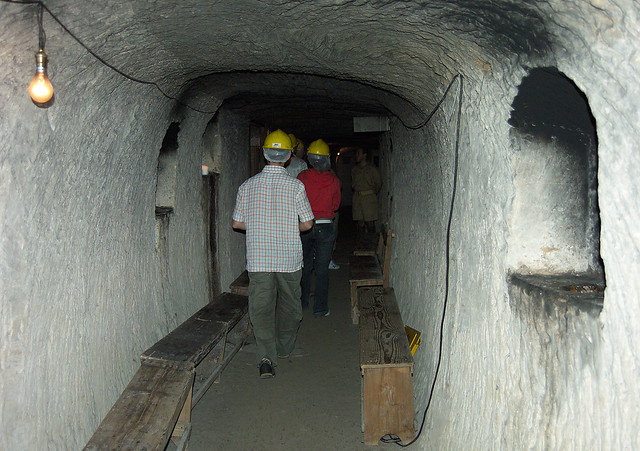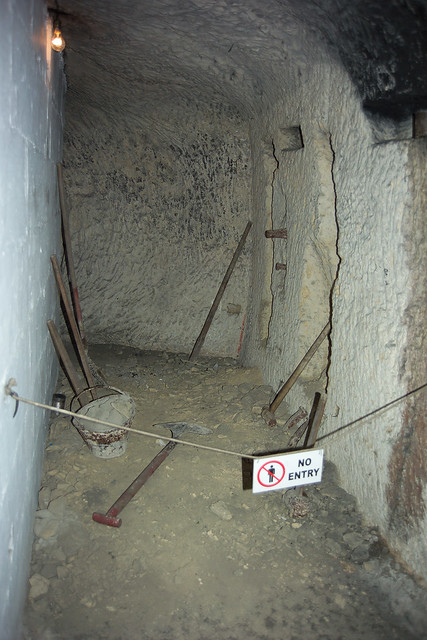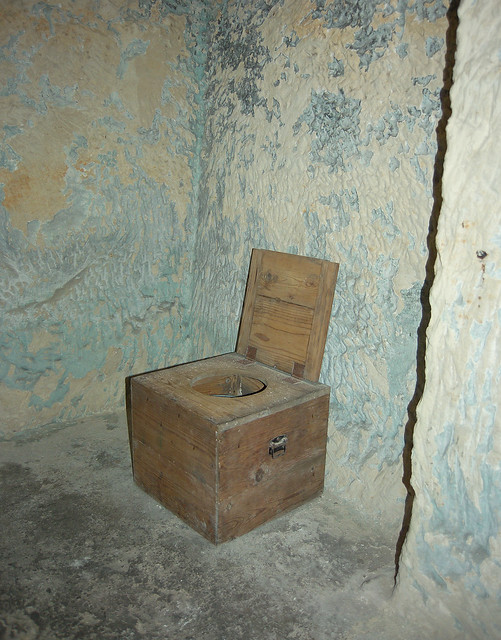As Europe tore itself apart during the second world war, Malta nudged it’s way into the record books as the most heavilly bombed place on earth. More bombs rained down on Malta in April 1942 alone that on London during the blitz. In the same month 6700 tons of bombs rained down on the island. By comparison, approximately 500 tons of high explosive are thought to have fallen in the devastating Coventry blitz of 1940.
To avoid this hell, the people of Malta spent a large part of their life underground in an elaborate network of shelters. Some of which can be visited today.
Mgarr Shelter
In the square in front of Mgarr’s impressive parish church is the “Il-Barri” restaurant. It has an excellent reputation for it’s traditional Maltese rabbit dishes but I had come to see the air raid shelter that is accessed through the back of the restaurant. I paid a modest 3 euro and was asked to wait a few minutes whilst the lights were switched on in the shelter. Then I was taken downstairs and was shown a newsreel film of Malta’s wartime privations. When the film was over we (me and one of the girls from the restaurant – I was the only visitor) passed through a door into the shelter itself. I was completely taken aback at the scale of what I saw.
The tunnel extends more than 200 metres underneath the center of Mgarr and would have had multiple entrances (nine if I remember correctly). The tunnel twists and turns and there are recreations of first aid posts, family rooms and school classrooms in little rooms off the main tunnel. I asked my guide whether she was from Mgarr. She was – her grandmother had given birth to one of her children here in this dark damp place.
Malta at War Museum
Another shelter that is open to the public can be found at the ‘Malta at War Museum’ close to the Couvre’ Porte gate in Vittoriosa. It is maintained by ‘ Wirtartna’, Malta’s Heritage Trust and when I visited, was staffed by two history students dressed in period military uniforms. After donning hairnets and safety helmets, we were lead underground through the gas proof (covered by a wet sack), blast proof (reinforced by a concrete lintel) door.
This shelter was one of about ninety under the city of Vittoriosa alone. Goodness knows what state the rest of them are in but the Couvre Porte shelter is in pretty good shape. Residents would have beed issued with a pass indicating which shelter they were to go to in the event of a raid. Of course, people were frequently in ‘the wrong place’ when an air raid started and they would be accomodated in the closest shelter. If it was full, they would make a dash to alternative an so on until space was found for them.
The steep set of stairs leads from the museum entrance past an infirmary area and into the main accommodation area of the shelter. In this network of dark, damp, smelly passages, hundreds of people would wait for hours on end until the raids finished. Today, the tunnels are lit by electric lamps but during the war there were no such luxuries. In niches cut into the rock, makeshift lamps burned olive oil and gave off a dim and smoky light. It must have smelled like a chip shop!
Families could get a little bit of privacy by renting a tiny room off one of the main passages. The only catch is that they had to dig the room themselves out of the solid rock! Limestone is quite soft as rock goes but it must still have been quite an effort working for hours on end with a pick axe in those airless conditions. My dad remembers digging a room with his father in their shelter in the village of Tarxien.
At intervals in the Couvre Porte shelter there were signs advising the shelter dwellers…
-
Don’t commit nuisances
-
Don’t smoke
- Don’t spit
I would have thought that both smoking and spitting would have been consideres nuisances and that the first line would have been sufficient, even in the chaos of wartime Malta. Were the good people of Vittoriosa such heavy smokers and flambouyant spitters that these misdemeanors had to be called out separately?
Talking of nuisances, image several hundred people gathered in one place for several hours with terrifying things happening all around them. The toilets would have been in quite some demand. The facilities in the shelter were rudimentary but adequate. A small room, curtained off from the main tunnel contained two wooden lavatories opposite each other. One of the less enviable jobs of the shelter officials was to empty the toilets after each raid.

